Shower cabin made of tiles: step-by-step construction instructions
Water procedures are a mandatory daily ritual for humans.But what should owners of small-sized apartments do, where the size of the bathroom does not allow them to accommodate all the desired plumbing fixtures? A compact shower cubicle is a modern alternative to a traditional bath. And the variety of materials for its arrangement allows you to turn it into a stylish shower room. Do you agree?
It does not require much space, saves water and time allocated for hygiene procedures. And most importantly, it is quite possible to make such a design yourself, according to your own design and measurements. Let's take a closer look at how a shower stall is made from tiles in three versions - with a ready-made or home-made tray, and also without it.
We will tell you how to build a tile shower yourself, what materials and tools you will need for this. The article also contains expert advice and the main nuances that you should pay attention to during construction. And the videos posted in the material clearly demonstrate the arrangement of a tile tray for a shower stall.
The content of the article:
Pros and cons of a tile shower
Although today in plumbing stores you can choose the furnishings to suit any interior style, homemade shower stalls do not lose popularity. The main reasons are the bulky dimensions and the impressive cost of truly high-quality factory products.
Budget options are most often made of inexpensive plastic and with cheap components, which soon manifest themselves in all their glory in the form frequent breakdowns. Some of them can be eliminated with your own hands, but to repair individual elements of the shower cabin you will have to turn to the experts.
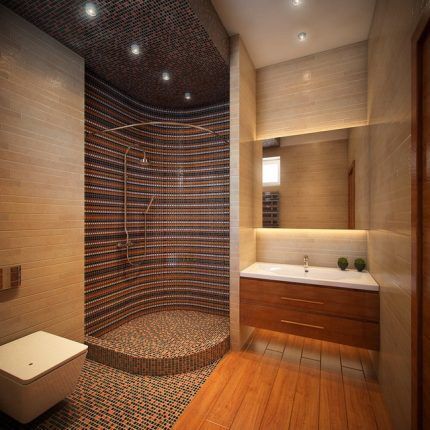
Additionally, many cabins are equipped with all kinds of electronics - from a radio point to a steam generator, lighting effects and a Charcot shower, the need for which is very doubtful, but they significantly increase the cost of plumbing.
In addition, factory products are manufactured according to a standard size range, which does not always fit small rooms in country houses or apartments of old buildings, where every centimeter counts.
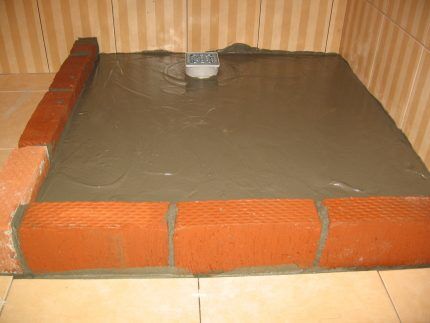
Therefore, a homemade tile shower has a number of advantages:
- Reliability and simplicity – the design with ceramic lining is much stronger than the plastic walls of standard shower cabins, so it will last a long time.
- Opportunity to create an original design – in addition to the shape of the booth itself, you can experiment with its design, because the range of mosaics, tiles and porcelain stoneware is very diverse.
- Safety and environmental friendliness – ceramics do not conduct electricity and do not emit unpleasant odors (unlike some types of plastic).
- Easy care – it’s easy to care for the tiles, they don’t turn yellow, don’t require detergents and can be easily cleaned of limescale after hard water and soap stains.
There are not so many disadvantages to a tiled cabin (of course, if its installation is carried out according to all the rules and in compliance with the slope). Mostly they note poor sound insulation, which can be solved by laying an additional layer under the screed or installing a ready-made pallet.
Also, many people think that taking a shower while standing on a cold tile is not very comfortable. But in fact, ceramics quickly heat up under a warm flow, and if desired, a “warm floor” system and an additional heat-insulating layer can be installed under such cladding.
Options for arranging a homemade cabin
If you decide to start designing the shower area in the bathroom yourself, first decide on the installation location of the future stall and its design.
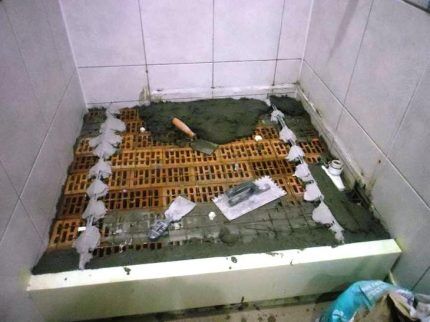
Depending on the height of the ceiling, the entrance to the sewer, the size of the free space and your construction skills, three options are possible: with a purchased pallet, a ladder or a homemade pedestal.
Option #1 - shower with a ready-made tray
If there is enough space in the bathroom, and the main goal of arranging a homemade stall is a non-standard design, you can easily make your task easier and buy a ready-made tray.
Moreover, in a plumbing store you can choose an option for any design and budget - it can be either the usual snow-white pedestal made of acrylic, or a product made of beautiful artificial stone or reliable cast iron.
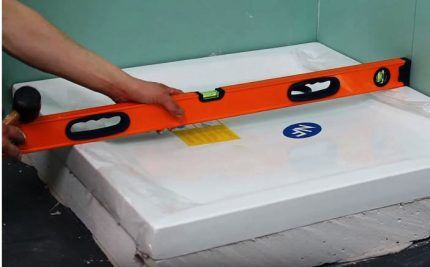
In addition to the pallet itself, for installation you will need:
- Flexible drain hose.
- Corrugation and siphon.
- Foam concrete.
- Tile adhesive.
- Silicone sealant with a gun.
- Tape measure, level and pencil for marking.
- Saw, wooden/rubber hammer.
- Tray and trowel.
The pallet is installed on a specially constructed foundation, under which communications will be hidden. First you need to make markings: place the pallet in the location chosen for installation and trace the contours with a pencil.
Then cut out four supports from foam concrete that will support the base of the future cabin, and check the evenness with a level (if necessary, the blocks can be easily trimmed).

Now you need to attach the drain. To do this, you need to return the pan to the supports and outline the location of the siphon on the floor through the drain hole. Remove the pallet again and attach siphon to the drain pipe so that it coincides with the markings.
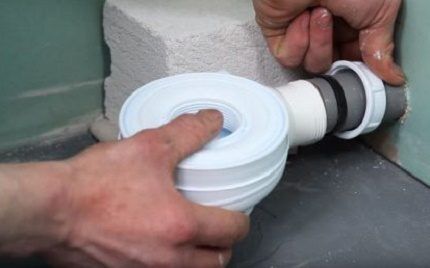
Then a foundation is erected from foam concrete blocks cut to the height of the supports and attached to tile adhesive. When the base is prepared, its upper surface is coated with the same tile adhesive, a pallet is placed on top and adjusted to a level with a wooden or rubber hammer.
At the final stage, it is necessary to ensure the tightness of the structure. To do this, wipe the edges of the pallet with a clean rag, degrease and apply silicone sealant along the joints. All that remains is to install the siphon in the pan and cover the foam concrete foundation with tiles.
Do you have an acrylic, cast iron or marble tray? On our website there is article with step-by-step instructions for installation of pallets made of various materials. We recommend that you familiarize yourself with them.
This is interesting! 10 best construction mixers: review, advantages and disadvantages, price.
Option #2 - design of a cabin with a gangway
An effective solution that looks attractive in photographs of modern interiors is a single-level cabin without podiums or differences.
This shower enclosure is ideal for small bathrooms, especially if it is equipped with transparent glass doors, and the walls and floor are made of the same materials or in a similar color scheme to the main finish. The result is an airy and stylish design.
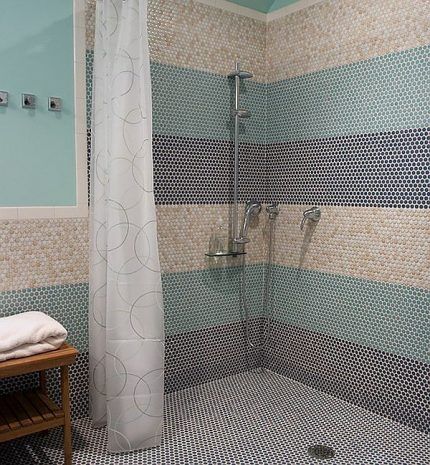
To do this, you need to equip the corner not with a pallet, but drain ladder. But it is best to plan such a structure at the renovation stage, because you will have to raise the floor by at least 15 cm in order to hide communications under the concrete layer.
The second option is to drill a hole in the screed for the drain and a groove for supply to the sewer pipe. But this is the case if the thickness of the “pie” on the floor makes it possible to disguise communications, because it is impossible to chisel the floor slabs.
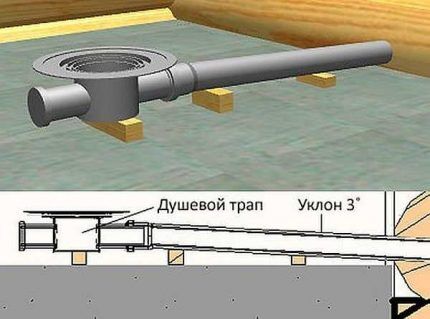
Important recommendations for arranging a drain ladder:
- First you need to make markings for the future cabin, determine the place for the drain bowl where the water from the shower will flow.
- Then, to the place of the shower drain, you need to connect a pipe entering the sewer drain. Here it is advisable to provide a slope of 3% (although 1-2% is possible for a linear drain) and a permissible angle of rotation at the entrance to the sewer within 30-45°. If these conditions are met, you can clear the clogged pipe with a regular plumbing cable.
- After measurements, the drain is installed on supports of the required height and connected to the pipe.
- When all communications are installed and connected, you can screed with concrete. But here, too, it is important to make a bevel of 4-5 cm for each meter of length towards the drain bowl, so that the water does not stagnate on the floor, but goes into the drain.
At the final stage, you need to make a water supply and close the booth with glass or plastic doors, which you can buy along with fasteners at a plumbing store or make yourself.
In an economical option, for example, when organizing a shower in a country house, you can get by with curtains made of polyethylene or waterproof fabric.
Option #3 - shower with a homemade tray
Instead of a factory podium, you can make a solid base for the booth on a brick or concrete foundation, which will only need to be covered with ceramic tiles or mosaics.
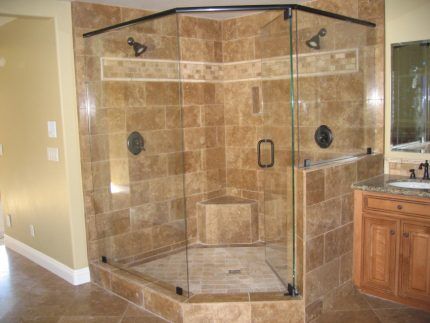
But such a major decision may turn out to be very difficult to implement in practice, because in addition to the pedestal itself, you will need high-quality waterproofing, and the plumbing connections need to be thought out in detail.
Therefore, we will consider in more detail the main stages of such construction, so that it is easier to assess the scope of the upcoming work and our own strengths.
Making a booth from scratch: step-by-step instructions
First, decide on the shape of the future booth and make markings for it on the floor. The easiest way is to make a square or rectangular shower in a corner or niche, but if desired, you can also build a trapezoidal or semicircular structure.
But although a lot here depends on the layout and availability of free space in the bathroom, keep in mind that the minimum dimensions of a comfortable cubicle are 90*90 cm.
Step #1 - select materials and tools
To set up a booth, you will need the usual set of tools, which are likely to be found in the home craftsman's supplies: a level, a pencil and a tape measure, a trowel for mortar and glue, spatulas for grouting, a roller and a brush.
To mix the solutions, it would be a good idea to stock up on a construction mixer, otherwise you will have to prepare the mixture manually.
Materials you need to prepare:
- Moisture-resistant single brick (silicate brick can also be used, but must be treated with hydrophobic agents).
- Reinforcement mesh with cells 10*10 cm.
- Mixture for screed M-200.
- Waterproofing mastics or rolled materials.
- Insulation.
- Tile or mosaic with crosses for layout.
- Tile adhesive, grout and acrylic sealant.
It is also necessary to purchase plumbing parts in advance for drainage arrangement – pipes, drain or siphon with all necessary connections.
Step #2 - install pipes and build a foundation
So, the place has been chosen, construction can begin. First you need to remove the old covering from the floor and walls.
If the floor is fairly level, you can treat it immediately waterproofing material, but if there are significant differences, you should first perform a rough screed (for heat and sound insulation, you can lay glass wool, expanded polystyrene or mineral fiber).
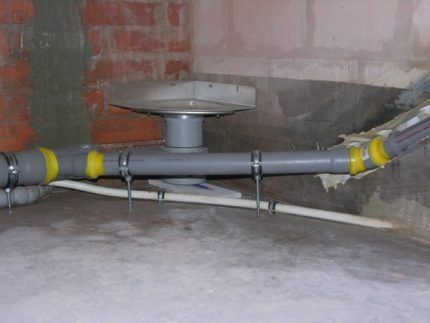
The issue of connecting to sewerage and water supply should be treated extremely carefully. All joints must be sealed and treated with sealant. If you have never done such work, we recommend that you view detailed instructions on connecting the shower to communications.
After drying, insulation, for example, bitumen mastic or liquid rubber, is applied to the surface of the floor and wall. You can also use rolled materials, but the ideal option is polymerizing impregnations (liquid glass), which are used to insulate swimming pools.
When they harden, they form a water-impermeable coating that will reliably protect against leaks.
The pipes should also be treated, leaving only the valves and outlets open.
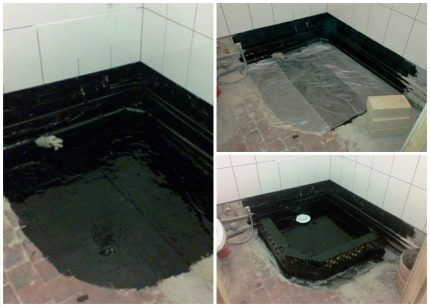
For the base, you can take a moisture-resistant red brick, which is laid on tile adhesive for masonry along the perimeter of the future cabin, forming the sides. Then a drain with a water seal or a standard siphon is installed and connected to the sewer pipe.
After this, the floor is laid with bricks or filled with a self-leveling mixture (3-5 cm thick) using reinforcing mesh.
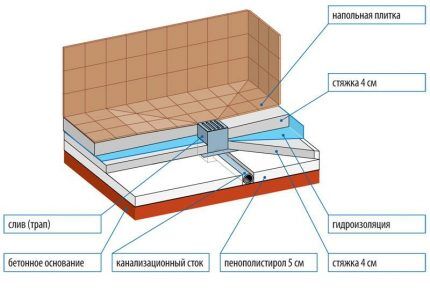
All that remains is to carefully rub all the joints and cracks with a solution of sand and cement, dry and coat them again with waterproofing without affecting the siphon.
We have another article on our website in which we looked in more detail at the process of independent making a pallet from tiles, providing the material with step-by-step photos.
Step #3 - assemble the frame and lay the tiles
If you want to create a full-fledged stall, and not a shower corner, you need to erect partitions. Depending on the location, the cabin is already adjacent to the room wall on one or both sides.
The missing partitions can be made from moisture-resistant plywood or plasterboard and then covered with the same tiles or mosaics.To do this, you need to build a frame from a metal profile, sheathe it with plasterboard, smooth the seams with putty and prime the surface.
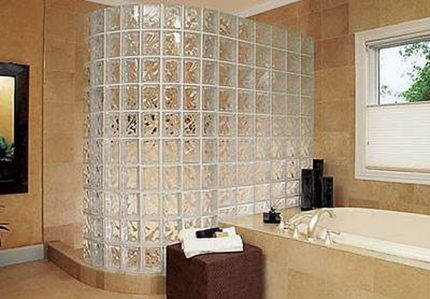
In order for the finishing to lay beautifully, it is important to level the surface of the frame well, especially if you want to cover it with a mosaic that is capricious in terms of the quality of the base.
To do this, you can use plaster followed by treatment with moisture-resistant impregnation or a gypsum mixture.
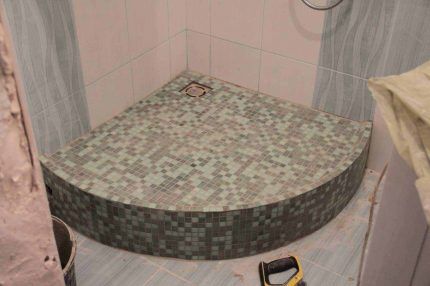
After leveling, attach the cladding with tile adhesive and treat the seams with moisture-resistant grout. When the solution has hardened, apply sealant to the joints between the tiles and the shower walls.
The better the installation and the smaller the gaps between the tiles, the longer the decorative coating will last in a humid environment.
Step #4 - install doors for the booth
To prevent water from splashing all over the bathroom during hygiene procedures, it is advisable to enclose the shower area on all sides. The simplest option is to arrange plastic screen or waterproof curtains.
But this solution is more suitable for a shower in the country, but it is unlikely to decorate a room in an apartment. Therefore, you can buy ready-made sliding, folding or swing doors or make them yourself from plasterboard or plywood.
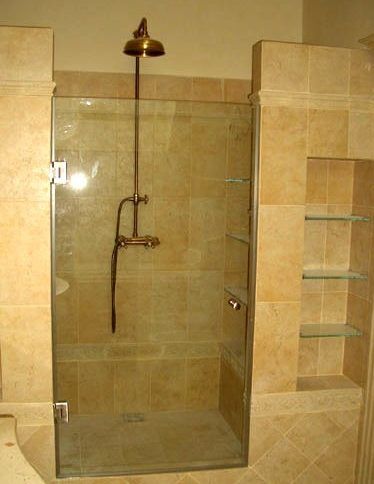
But still, the best option (both in design and level of moisture resistance) for arranging the partitions of a homemade booth is sliding polycarbonate or glass doors, at least 6 mm thick.
The ends of the blanks can be cut and processed in a glass workshop, and installed using ready-made canopies that are attached to both the ceiling and walls.
Construction and design tips
To create your own unique design, you can combine various materials, without forgetting about the practicality and safety of the future shower. For example, for the floor it is advisable to choose small embossed tiles or mosaics - there is less chance of slipping on a rough surface with frequent seams.
As a finishing material for the pallet, you can use multi-colored pebbles or other decor, filling the finishing layer with a transparent sealant.
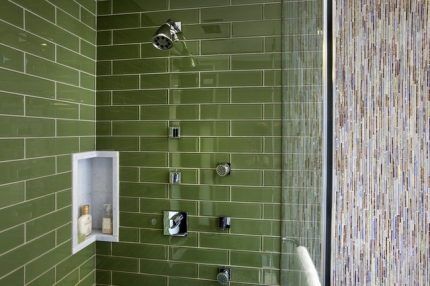
A few important nuances:
- To prevent water from building up in the pipes, an important rule must be observed: the entrance to the sewer must always be below floor level. The height of the pan with a built-in siphon or drain depends on this.
- Before installing the drainage system, pay attention to the drainage capacity: the larger it is, the faster the water will leave the pan.In some cases, for example, for a cabin with a rain shower function, a standard drain may not cope with the flow of water.
- It is best to lay whole tiles or mosaic sheets on a pallet. To do this, at the stage of marking the booth, you can make a dry layout. If you cannot do without undercuts, install end caps on the cut.
When creating the design of your future cabin, think about comfortable little things.
At the construction stage, it is easy to provide various shelves or niches for placing all kinds of shampoos, gels and other hygiene items, or build a small chair covered with tiles.
Conclusions and useful video on the topic
For a more complete understanding of the various nuances and stages of work on arranging homemade booths, we suggest studying several videos with advice from experts.
How to install a linear drain for a shower enclosure:
How to make a booth with a tile tray and heated floor:
The initial stage of pallet construction is height calculation, rough screed:
Installing a drain and insulating the floor in a shower stall:
How to make a floor screed for a pallet:
The construction of a homemade shower stall with tile or mosaic cladding allows you to bring the most creative design ideas to life. And if all the work is done efficiently, not forgetting about slopes and waterproofing of surfaces, such a shower will last much longer than plastic cabins.
But if you are not confident in your construction skills, you can always hire professional builders or plumbers to do the work.
Do you like tile shower stalls and want to build one for yourself? If you still have questions or have any questions after reading our instructions, ask them in the block below.
Or would you like to supplement our material with practical recommendations for laying tiles and connecting to the water supply/sewage system? Perhaps you have just completed the construction of a shower stall? Write your comments and advice, add photos of a booth you made yourself - your experience will inspire many newcomers to this business.




I built a shower stall with a drain in my apartment. The bathroom is rectangular, I had to choose between a bathtub and a washing machine, I chose a top-loading washing machine and a shower. I made the drain myself, fortunately I have the skills, and there is nothing complicated. I still laid new sewer pipes, threw out the old cast iron and put in plastic ones. I hung a curtain in the shower and tiled the walls. It turned out not expensive, but beautiful and eternal, as they say seriously and for a long time. Ideal for small bathrooms. If anyone does this, pay attention to the slope so that the water goes into the drain and does not stand.
It seems to me that making a shower without a side is not at all practical. I have a shower stall with a large tray and it often gets clogged, even though the mesh costs extra. And then if it clogs up, the water will come through the top, because it will have nowhere to go. I wonder if there are any smells from the sewer in this situation?
Hello. If you choose a high-quality drain with a siphon and a filter grid as a water sealing mechanism, you will definitely not have problems with blockages and odors. And besides, if the slope is maintained, problems also do not arise.